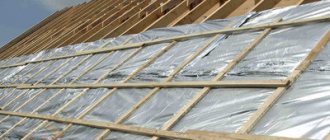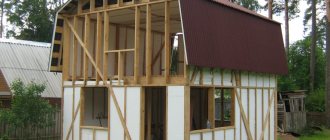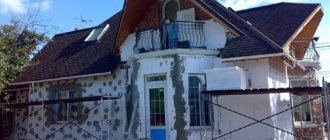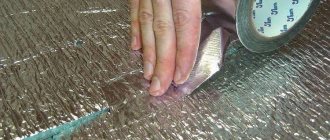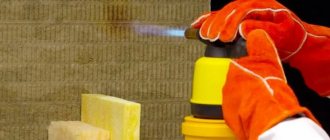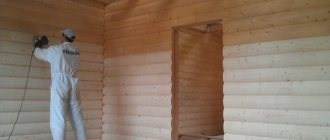Only a true housewife and owner can preserve the warmth of the family hearth - this requires patience, experience, dexterity and love for your home. As for physical heat, it all depends on the materials chosen, a well-thought-out heating system and thermal insulation of the house.
Properly designed communications and installation of thermal insulation will provide the dacha with protection from cold winds and frosts in winter, giving a comfortable atmosphere in the rooms. In addition, good thermal insulation of the cottage will help you save on heating and electricity bills.
If you have seriously decided to extend your dacha season into the winter months, don’t hesitate - insulate your dacha! In order to do this as quickly as possible and with your own hands, there are several simple techniques. These secrets will help you relax in warmth and comfort at your dacha all year round.
However, we note that there are two difficulties in this matter. First, it is important to choose the right materials. Secondly, it is important to check everything before the cold weather sets in. We will talk about these and other nuances in this article.
Material selection
There are a number of requirements for thermal insulation materials.
The insulation must have low thermal conductivity, good hygroscopicity, fire safety and environmental friendliness.
It is necessary that the material reliably prevents heat exchange between the external and internal parts of the walls and protects the structure well from the inside.
Today, mineral wool based on basalt or fiberglass is widely used as insulation. If the ventilation of the house is properly equipped, moisture will not be a problem for this material.
New products for high-quality do-it-yourself insulation of a dacha are constantly appearing on the construction goods market. For example:
- insulation made of flax fiber - the material is produced in slabs, is easy to cut, does not change shape, is environmentally friendly, has good antiseptic properties;
- ecowool is a sprayed loose heat insulator consisting of recycled cellulose with the addition of antiseptics and fire retardants;
- soft fiberboard (fiberboard) is an environmentally friendly material that can be used to immediately strengthen walls.
How and with what to insulate is a matter of taste and good choice. The main thing is that the country house is reliably protected from the winter cold.
Penofol or penoplex
There is no point in comparing these two materials with those discussed above, since their price is superior to both foam plastic and mineral wool. Speaking about them, we note that penofol and penoplex are modern thermal insulation materials that are distinguished by excellent performance characteristics. Especially in this regard, penofol stands out, which experts call combined because it has three layers in its structure:
- waterproofing;
- thermal insulation;
- vapor barrier.
When installing penofol, they resort to the use of a special adhesive composition. But to install penoplex on the surface, special fasteners are used - fungal screws. You should know that penoplex is a panel with a smooth and even surface, which facilitates the process of laying finishing material on top of it.
Roof
If installed incorrectly, a roof can “steal” more than 10% of the heat spent on heating the house.
When choosing thermal insulation for a roof, pay attention to its service life, which depends on many external factors: temperature fluctuations, amount of precipitation (especially snow), wind strength and direction. Pay special attention to the water resistance of the material. Isolation must also be safe for health. The first sign of safe insulation is the absence of a sharp, pungent odor.
Insulating the roof with polymer materials is not the best solution. They ignite very easily and quickly, so increased fire safety measures will have to be taken.
The best insulation for roofing can be considered stone wool, which is intended for thermal protection of structures that do not bear heavy loads.
How to insulate a garden house for the winter
The most practical materials for thermal insulation of a summer house are basalt materials, expanded polystyrene or foam plex boards. Expanded polystyrene should be used for self-insulation of foundations and blind areas.
Penoplex boards are a dense and durable material that is not afraid of high humidity, however, these materials can emit harmful substances.
Insulation of a garden house for winter living
When using mineral wool, high-quality vapor barrier is required on the side of the warm room.
When laying, mineral insulation materials should be placed tightly into the frame. It is believed that mineral wool is not eaten by rodents and is environmentally safe for humans. In order for the thermal insulation layer to be optimal, you should first calculate the thickness of the wall insulation using a thermal calculator.
Walls
Insulation of walls is the main stage of work, since they occupy the main area of any building and have the highest heat transfer.
Surface preparation
Before insulating wooden walls, be sure to clean the entire surface of dirt. Carefully treat the inside of the walls with special solutions and aerosols that will protect the wood from insects. Then caulk all the gaps using dry tow and a thin chisel.
Insulation
Jute fabric is very suitable as a heat insulator for walls. It is quickly and easily laid with a construction stapler, does not rot, is not blown away by the wind and is not of interest to moths. Tow and jute fiber have low thermal conductivity due to their capillary structure and easily release moisture. In addition, as bactericidal materials, they successfully resist the spread of fungus.
It is not recommended to use improvised materials to insulate the walls of a country house: felt, batting, wool. They accumulate moisture abundantly. As a result, the process of rotting quickly begins, and moths are sure to appear in the wool.
Roof
According to statistics, a house loses from 10 to 30% of heat through the roof if no attempts are made to improve its thermal insulation. Therefore, if you are determined to convert your summer country house into one suitable for winter stays, then it is simply necessary to pay attention to the under-roof space.
The insulation technology will directly depend on the type of roof in your house. For example, if there is a cold attic between the roof slopes, then the simplest and most inexpensive method of insulation would be to pour a layer of sawdust on the roof with a layer of at least 30 centimeters. Wooden sawdust meets several requirements at once: firstly, they are cheap, secondly, they are environmentally friendly, and thirdly, they perfectly fill all sorts of unevenness and joints of floors. They retain heat quite tolerably and reliably protect from drafts. So if you are looking for a “cheap and cheerful” option, sawdust will help you.
Photo: odstroy.ru
Another quick and cheap way is polystyrene foam. It’s also fast, cheap, and you don’t have to carry heavy bags of sawdust into the attic. But there is one big fat minus: polystyrene foam is a very attractive place for mice to settle. And even if you are not afraid of them, a mouse colony on the roof can create two types of inconvenience for you. The first is harmless: when the mice begin to fuss and wander around in their foam palaces, you will hear them clearly. And the second is more formidable: mice can carry hemorrhagic fever, outbreaks of which occur with enviable frequency in Tatarstan. For example, you risk catching a disease in the spring when you clean your country house after winter. Therefore, it is still not recommended to breed mouse colonies in the house. However, if you equip your foam attic with reliable means of protection from unwanted residents, foam will become a good way of insulation.
You can sheathe the floors, ceiling or roof from the inside with mineral wool - mice will no longer settle here. The material, however, will be more expensive.
Window
After insulating the walls, we move on to the windows. They also lead to significant heat loss, so close attention should be paid to windows, especially if the design is outdated.
Cleaning and waterproofing
The frames of the house should be thoroughly cleaned of dust, cracked glass should be replaced, and the gaps between the walls and frames should be sealed.
For high-quality insulation you will need silicone sealant in a special gun. It reliably protects joints from the inside from fungi and mold.
Polyurethane foam will also work. However, it quickly deteriorates from the sun and is not entirely aesthetically pleasing. If you choose foam, you will have to take measures to protect it from ultraviolet rays.
D-profile tape
Then you need to glue the sealing tape. D-profile tape is best suited. It effectively closes gaps up to 7 mm. For a more secure fixation, you can secure the tape with nails or staples.
Film on glass and insulation of slopes
To maximize the insulation of windows, cover them with heat-saving film. This material is applied directly to the glass. When laying the film there should be no folds, swelling or bubbles. Carefully done work will help save more than 30% of heat.
Don't forget about insulating the slopes. For this, you can use various materials, for example, polyethylene foam or mineral wool. The insulation is fixed to the slopes using glue.
Ceiling insulation technology
There is no such thing as too much insulation, so many people try to insulate both the roof and the ceiling from the inside of the room. A house for permanent residence is usually insulated from the outside, but it is not forbidden to sheathe country houses with insulation from the inside. For example, thermal insulation in the form of slabs is recommended for the ceiling - it is convenient and effective. You can choose at least the same mineral wool in a slab version. But, of course, one mineral wool will not be enough: you will have to tinker.
So, first you need to clean the ceiling from dirt and dust. Then attach the beams at a distance approximately equal to the width of the insulation boards - this will be the sheathing. The thickness of the beams should be approximately the same as the slabs themselves that you are going to use.
Photo: market-crimea.com
A waterproofing film is attached to the finished sheathing, which will lie between the bare ceiling and the future thermal insulation. For example, basalt wool or slabs of other insulation are attached on top of the waterproofing with glue or a construction stapler. If there is a cold attic on top without sawdust and other luxuries, then the slabs must be thick enough to withstand the full power of the Tatarstan winter. It’s better not to be greedy and take a thickness from 10 to 16 cm.
Finally, the insulation needs to be covered with a vapor barrier (and laid on the correct side - we also already talked about this). This is necessary so that moisture vapor can easily pass through the entire “pie” and not accumulate inside the house. Finally, transverse counter-battens are mounted on top - and then the finishing ceiling.
Finally, you can choose foil material - a special film. It is less effective in terms of heat conservation, but if it is installed correctly, the house will definitely become warmer. And literacy lies in this: between such a film and the main ceiling, you must leave an air gap, which will additionally retain heat. Therefore: we attach the sheathing to the ceiling and attach the foil film to it, joint to joint (foil side down!). Installation seams must be taped, preferably with aluminum tape. Next is the counter-lattice, and then the finished ceiling.
Photo: pol-exp.com
Floor
There are many modern materials for floor insulation. The main thing is that the inside of the country house is as dry as possible.
Styrofoam
Expanded polystyrene does not absorb moisture, is durable, strong, and a good antiseptic. It is convenient to work with such material because it does not change the original volume.
Minvata
Mineral wool is sold in various versions: rolls, slabs, mats. Low density, environmental friendliness, wear resistance, relatively low price are its main advantages.
Penofol
The new material penofol has already shown its best side and has gained popularity. It is sold in rolls consisting of a layer of foil and insulation. Most often, the base is foamed polyethylene.
Requirements for insulation
When choosing a material for insulating a dacha floor with your own hands, do not look for the cheapest options and be sure to remember that the insulation must be:
- environmentally friendly, safe for health;
- excellent heat insulator;
- durable.
Proper ventilation
However, it is not enough to know how to insulate a garden house from the inside: a properly equipped ventilation system is also important. For a comfortable stay in the house, supply valves and ventilation ducts for air outlet are necessary. If ventilation ducts run in unheated areas of the house, they must be insulated to avoid moisture condensation.
Today it is customary to install valves for fresh air in window units. Forced ventilation is advisable in damp rooms: in the bathroom and kitchen.
Thus, an ideal microclimate will be maintained throughout the house.
Floor insulation methods
There are several ways to insulate the floor of a country house.
Double floor
The bottom layer of rough boards is carefully attached directly to the beams. A “finish” coating is laid on the “rough” structure.
Floor insulation using joists
Wooden logs are installed on the foundation in increments of 0.5–1 m or cut into the frame. Next, the “rough” floor is laid. The free space is filled with thermal insulation. Quite a simple and effective way. You can insulate the floor using joists installed on brick columns. Any insulation: mineral wool, fiberglass, polystyrene foam or other suitable material. The distance between the finished floor and the ground increases. The work does not require builder experience and can be easily done with your own hands. With this option, the insulating material does not experience stress, which makes the method of insulating a wooden floor along joists ideal.
Sex question
As a rule, up to 10% of the heat from the house escapes through the floor. And the lion's share of these losses is associated with icy drafts at the junction of the walls and the floor.
And this is where foil insulation will become a definite boon if you need to quickly and cheaply insulate the floor. You need to start with the joints of the floor and walls: it is into these cracks that heat flows out of your home in winter. Cover these cracks with strips of foil insulation, nailing it to the walls and floor with nails or a construction stapler - and you will already save the lion's share of heat. We remind you again: the layer of foil should look inside the room, and not shyly rest against the floor.
If cracks in the floors haunt you throughout the entire area of the room, take courage, dismantle the floor and lay foil insulation under the floor covering.
Lyudmila Gubaeva
Real Estate Tatarstan
Let's summarize the comparison
Both materials are characterized by high thermal insulation characteristics.
Therefore, they are most often used to insulate walls in apartments. Their common advantage is that there are no problems with the installation of these insulation materials. Even a person who is far from thermal insulation work can cope with this task on his own. However, there are certain nuances when using them. Laying foam can be done using a frameless method. An adhesive composition is used to secure the insulation to the wall. When thermal insulation is carried out using mineral wool, the creation of a frame is a prerequisite. On the wall, vertically installed slats will act as fastening elements. In terms of installation costs, the use of polystyrene foam is beneficial. In terms of cost, this particular material is also beneficial. Its price is three times lower than mineral wool. However, when deciding to opt for polystyrene foam, you must keep the following in mind. If rodents appear in your home, they will use foam sheets to build their house. They can destroy insulation sheets, which will lead to increased heat loss.
When thinking about which thermal insulation material to choose, you should first consult with a specialist who, taking into account the room, will recommend you a suitable insulation.


